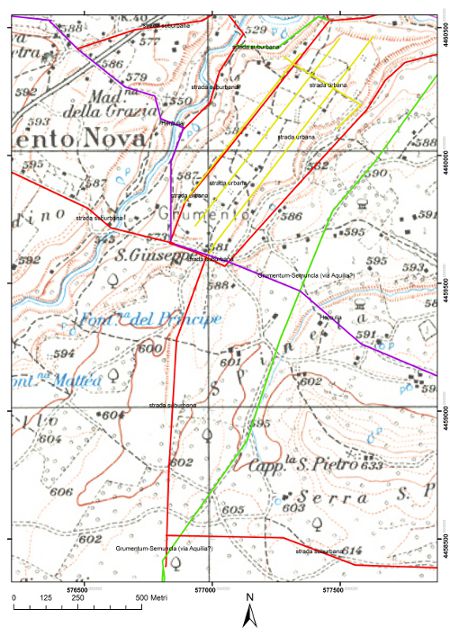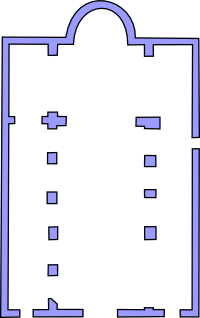Christianization of Grumentum areaby Gioia Bertelli
The beginning of Christianity in Grumentum is tied to the figure of the martyr Laverio; about him we have a passio in latin written by Roberto da Romana, deacon of Saponara (now Grumento Nova) in 1162, from which can infer that Laverio was beheaded in the early fourth century, before emperor Constantine converting himself to Christianity, in an area located at the confluence between Agri river and Sciaura stream, and he was buried there, probably in the necropolis of Roman age that was placed not so far from the urban setting. The cult for Laverio implied that over the grave of the martyr was built a church, found during recent archaeological researches, which was divided in three aisles, with apse, then replaced in tenth century by a smaller one, built by Luke of Demenna (cfr. the schedule about the sacred context of St. Laverio). The devotion to the martyr of Grumentum made that his body relics were transferred to other near areas, as stated in the passio by Roberto da Romana (Acerenza, Tito, Satriano, but also Tricarico, Teggiano, in Valley of Diano, Laurignano (in Calabrian territory) that celebrate him the 17th of November.
Remains of a church dedicated to St. Marie Assunta are still visible near the Roman amphitheatre; this area has not been investigated yet, but probably the building, that should have incorporated that one of early Christian age, was still in use between thirteenth and fourteenth century, period to which would seem possible assign a fragment of fresco with the image of a saint found in the central apse.
Text anc image copyright testo e immagini by Gioia Bertelli. |




 Lucania region records from the late fifth century the presence of Episcopal sees in Potenza, Venosa, Acerenza and Grumento, areas located mainly in the north-western part of the region and linked by roads such as Via Appia, Herculia, Popilia, Ionian coastal road; however the central and Ionian part of the region seem to haven’t any news related to any Episcopal presence. Grumentum, on the other side, is remembered at the time of Pope Gelasio I (492-496) as assigned to the deacon Quarto, appointed, following the papal wish, by Sabino, bishop of Consilinum; also in two other epistles the see seems to be entrusted to an archdeacon; as Episcopal see is mentioned for the first time in a epistle (558-560) of Pope Pelagio I sent to bishop Tullianum, who turned to the pope asking if he would accept the election of the deacon Latin of Grumentum as bishop of the near diocese Consilinum-Marcellianum, according to the procedure provided by Roman Church; again in 599 in an other epistle addressed to Romanus, defensor of ecclesiastic heritage in Sicily, Pope Gregorio Magno mentions a certain Luminoso… servum sanctae Mariae, quod est parochiae ecclesiae Grumentinae, certifying in this way still the existence of the diocese, whose cathedral was dedicated to St. Marie.
Lucania region records from the late fifth century the presence of Episcopal sees in Potenza, Venosa, Acerenza and Grumento, areas located mainly in the north-western part of the region and linked by roads such as Via Appia, Herculia, Popilia, Ionian coastal road; however the central and Ionian part of the region seem to haven’t any news related to any Episcopal presence. Grumentum, on the other side, is remembered at the time of Pope Gelasio I (492-496) as assigned to the deacon Quarto, appointed, following the papal wish, by Sabino, bishop of Consilinum; also in two other epistles the see seems to be entrusted to an archdeacon; as Episcopal see is mentioned for the first time in a epistle (558-560) of Pope Pelagio I sent to bishop Tullianum, who turned to the pope asking if he would accept the election of the deacon Latin of Grumentum as bishop of the near diocese Consilinum-Marcellianum, according to the procedure provided by Roman Church; again in 599 in an other epistle addressed to Romanus, defensor of ecclesiastic heritage in Sicily, Pope Gregorio Magno mentions a certain Luminoso… servum sanctae Mariae, quod est parochiae ecclesiae Grumentinae, certifying in this way still the existence of the diocese, whose cathedral was dedicated to St. Marie. However to St. Marcus was dedicated the other small church identified outside of urban area, dated to sixth century; the building should be articulated in three aisles, divided by pillars, ended with an apse in the eastern part; in front of the façade there were, in a space laterally limited by two dividing walls, graves of different kind: one of Capuchin style, one coffer grave made with reused stone blocks from Roman age, covered by big tiles, with internal divisions to guest more depositions. The discovery of a silver coin of Imperator Eraclio (610-641) in one of the graves, in addition to the few ceramic kit goods offering common and recurrent forms between sixth and seventh century in Puglia and Lucania, allows a better time definition of attendance in the area for burial purposes. From the area come three low quadrangular capitals in limestone, made reusing burial slabs of Roman age, similar in size (70x70x24 cm) and decorative motifs. On two opposite sides appears a simple cross of Latin style; on the other two a central lily motif flanked by two flat caulicules ending to the corners in two curled volutes, the yield and the choice of motifs present again the same decorations on a capital coming from St. John of Ruoti, of late fifth century. Probably from Grumentum is the slab, broken at the bottom, decorated with Christological monogram in a clypeus formed by a leafed crown flanked by two bunches, datable to sixth century, now reused on the external walls of the cathedral of St. George in the nearby small city of Marsiconuovo, which became bishop see around the mid-eleventh century.
However to St. Marcus was dedicated the other small church identified outside of urban area, dated to sixth century; the building should be articulated in three aisles, divided by pillars, ended with an apse in the eastern part; in front of the façade there were, in a space laterally limited by two dividing walls, graves of different kind: one of Capuchin style, one coffer grave made with reused stone blocks from Roman age, covered by big tiles, with internal divisions to guest more depositions. The discovery of a silver coin of Imperator Eraclio (610-641) in one of the graves, in addition to the few ceramic kit goods offering common and recurrent forms between sixth and seventh century in Puglia and Lucania, allows a better time definition of attendance in the area for burial purposes. From the area come three low quadrangular capitals in limestone, made reusing burial slabs of Roman age, similar in size (70x70x24 cm) and decorative motifs. On two opposite sides appears a simple cross of Latin style; on the other two a central lily motif flanked by two flat caulicules ending to the corners in two curled volutes, the yield and the choice of motifs present again the same decorations on a capital coming from St. John of Ruoti, of late fifth century. Probably from Grumentum is the slab, broken at the bottom, decorated with Christological monogram in a clypeus formed by a leafed crown flanked by two bunches, datable to sixth century, now reused on the external walls of the cathedral of St. George in the nearby small city of Marsiconuovo, which became bishop see around the mid-eleventh century.